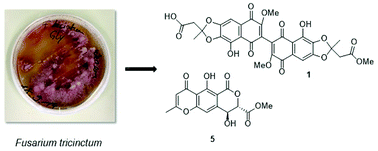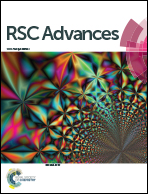Co-culture of the fungus Fusarium tricinctum with Streptomyces lividans induces production of cryptic naphthoquinone dimers†
Abstract
Co-cultivation of the endophytic fungus Fusarium tricinctum with Streptomyces lividans on solid rice medium led to the production of four new naphthoquinone dimers, fusatricinones A–D (1–4), and a new lateropyrone derivative, dihydrolateropyrone (5), that were not detected in axenic fungal controls. In addition, four known cryptic compounds, zearalenone (7), (−)-citreoisocoumarin (8), macrocarpon C (9) and 7-hydroxy-2-(2-hydroxypropyl)-5-methylchromone (10), that were likewise undetectable in extracts from fungal controls, were obtained from the co-culture extracts. The known antibiotically active compound lateropyrone (6), the depsipeptides enniatins B (11), B1 (12) and A1 (13), and the lipopeptide fusaristatin A (14), that were present in axenic fungal controls and in co-culture extracts, were upregulated in the latter. The structures of the new compounds were elucidated by 1D and 2D NMR spectra as well as by HRESIMS data. The relative and absolute configuration of dihydrolateropyrone (5) was elucidated by TDDFT-ECD calculations.



 Please wait while we load your content...
Please wait while we load your content...